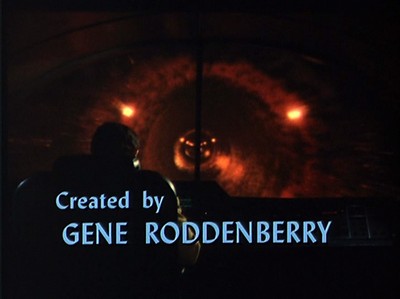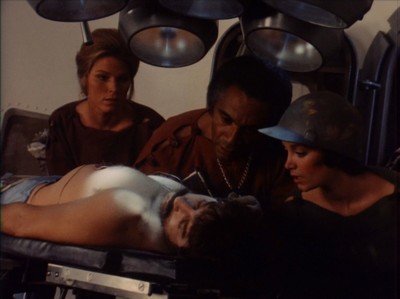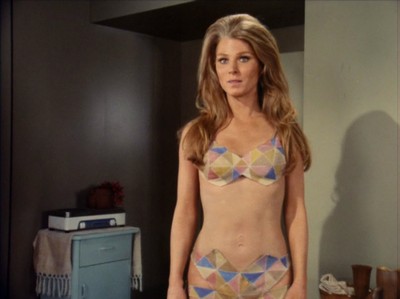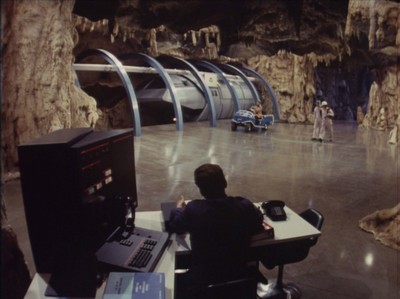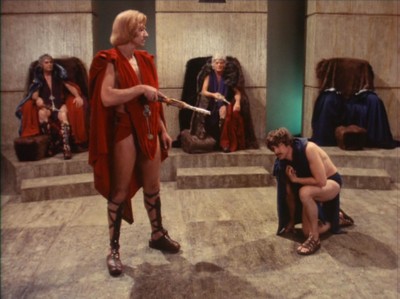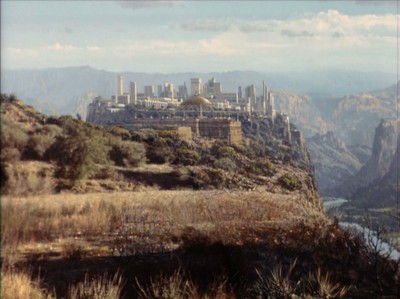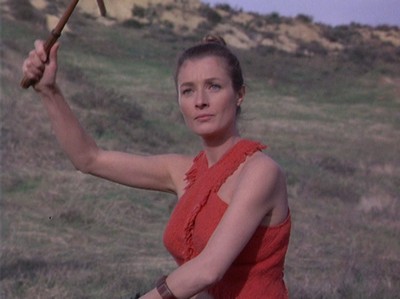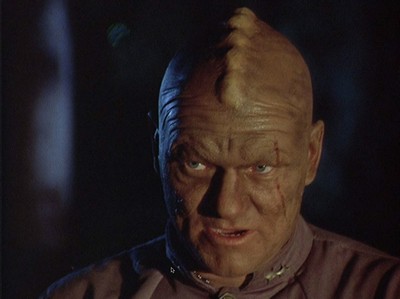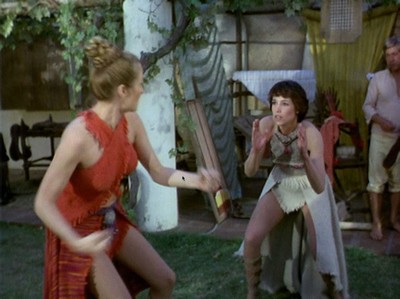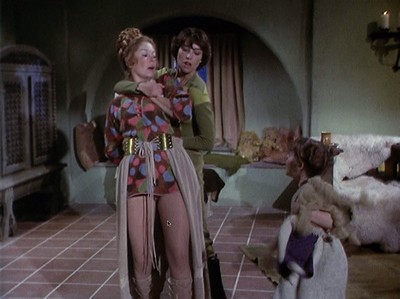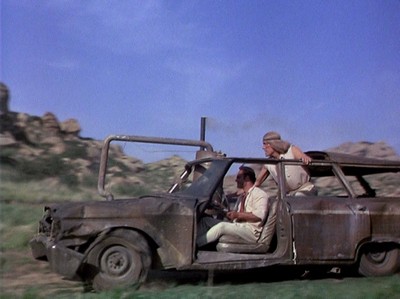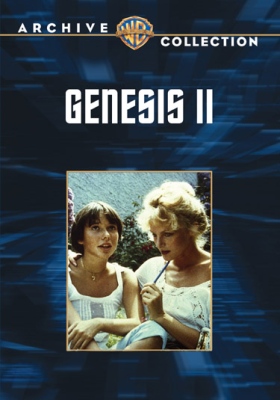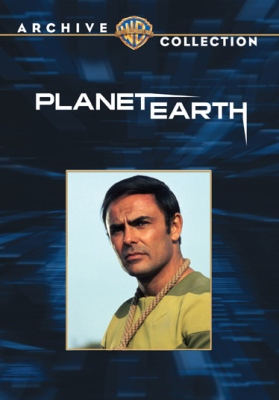Reviews: Gene Roddenberry’s ‘Genesis II’ & ‘Planet Earth’ (original) (raw)
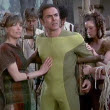
In the 1970s, between the end of Star Trek The Original series and the first Star Trek feature film, Gene Roddenberry developed a number of sci-fi TV pilots, which aired as TV movies, but never made it to series. Now Warner Brothers has made Genesis II and Planet Earth available via their video-on-demand DVD program. See below for our thorough review of both titles.
REVIEW: Roddenberry’s Lost 70s Pilots
In the early seventies with studios and the media just beginning to see the success of the original Star Trek in syndication, Gene Roddenberry’s reputation as the creator of a low-rated, cancelled television series was being rethought, and the producer found himself attaining celebrity status at burgeoning Star Trek conventions across the country. Roddenberry and his ideas were once again marketable and he began a series of attempts to get a new science fiction series on network television. The first two projects strangely followed a similar path to the original Star Trek—two pilots for what was essentially the same series about humanity picking up the pieces of civilization in the aftermath of nuclear war, and a Buck Rogers-like character put in suspended animation in the 20th century only to awaken and eventually become a leader in this strange new world.
Genesis II
Genesis II, directed by John Lewelyn Moxey and written and produced by Roddenberry, was the first stab at this idea. Alex Cord stars as Dylan Hunt, who’s using himself as a human guinea pig in experiments in suspended animation being conducted deep underground in Carlsbad Caverns when an earthquake cuts him off from his staff. Hunt is awakened in the year 2133 by three citizens of Pax, a hidden underground society. The rescuers are Isaac Kimbridge (Percy Rodriguez), one of the high council members of Pax, Harper-Smythe (Lynne Marta), a high-spirited young woman, and Lyra-a (Mariette Hartley), a mutant “Tyranian” who secretly warns Hunt that Pax is an oppressive, warlike society holding him hostage. Eventually Lyra-a helps Hunt escape to Tyrania, but as its name implies, Lyra-a’s home city is a tyranny of super strong (they have twin circulatory systems as indicated by Lyra-a’s double navel) but arrogant and hedonistic mutants who rule a slave underclass with cylindrical “stim” weapons that give pain or pleasure through hypersonic waves. Hunt eventually encounters agents from Pax infiltrating Tyrania, among them the hulking Isiah (Ted Cassidy), a powerful white Comanche, and Singh (Harvey Jason), an intellectual. As they explain, Pax too is exactly what it sounds like—a society of peace devoted to preserving the best cultural elements of the past. Hunt helps the Pax team foment a revolution among the oppressed Tyranian “helpers” and helps the Pax team escape, but at the last minute remains behind to help the disgraced Lyra-a by repairing Tyrania’s faltering nuclear power station. Eventually he returns to Pax and reveals that he has set the nuclear reactor to explode in order to prevent the Tyranians from using nuclear missile technology against Pax.
Genesis II was released with some fanfare in 1973, with coverage in TV Guide and national newspapers, mostly enthusiastic about Roddenberry’s return to television and the Star Trek-like elements of Genesis II. Mariette Hartley’s double-naveled amazon mutant got the lion’s share of the coverage, with Roddenberry reportedly declaring that he gave the character two navels to make up for the fact that network censors didn’t allow him to show navels on Star Trek (if such a rule existed, Roddenberry got around it well before Genesis II). The pilot did feature a lot of Trek staples: a diverse cast of characters, notions of sexual and political equality placed alongside visions of cruel oppression, lots of sexual innuendo, women (and men) in revealing costumes, interesting gadgetry (an impressive “sub shuttle” system linking the world through underground tunnels, the collapsible stim torture devices and Pax stun guns that fired miniature darts). The idea was to create an earthbound (and thus relatable and easily filmable) locale for a series that would allow for the Trek concept of outlandish “alien” societies, but this time they would be even more recognizable offshoots of our own social trends.
Like Roddenberry’s first Star Trek pilot, “The Cage,” Genesis II is often static and intellectual. The show ran in a 90-minute time slot and is 74 minutes long, but there’s practically no action for the first 40 minutes, almost half the show’s running time. Alex Cord also paralleled Jeffrey Hunter from “The Cage” as a dark, intriguing but somewhat cold potential leading man. Cord was a former rodeo rider with a lot of initial experience in Westerns, including some spaghetti westerns midway through his career—this stood him in good stead in Genesis II’s horse riding scenes. But his thick, wavy hair, bristling mustache and somewhat cold-blooded line delivery gave him an oddly creepy, seventies porn star quality. This actually helps some of the drama in the pilot by making Hunt unpredictable and hard to read, especially late in the game when it seems he may be betraying his saviors from Pax.
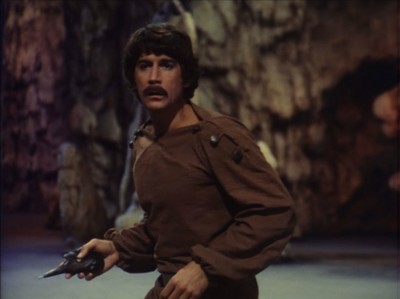
Cord as Hunt, wielding Pax dart gun
Several veterans from Star Trek make appearances in Genesis II, notably Percy Rodriguez (Commodore Stone from “Court Martial”), Majel Barrett (as a Pax elder), Mariette Hartley from “All Our Yesterdays” and Ted Cassidy from “What Are Little Girls Made of?” Hartley actually makes the strongest impression, and not just because of her fetishized costumes and the trademark all-American beauty that had made her a popular TV guest star since the sixties. Lyra-a is easily the most interesting character in the story, a woman who infiltrates Pax society, plies Hunt with lies about his rescuers, then quickly and believably transitions from an earnest ally to a dangerous and cruel Tyranian leader. Hartley’s best moment might be her bursting into a cavern of terrified “helpers” and shouting an order for obedience, her face flushed with a righteous fury we haven’t seen in her character until this moment. Of course Lyra-a is crippled by the one vulnerability so many Star Trek sirens were unable to overcome: their weakness for the show’s leading man. If anything
Genesis II’s storyline gets redundant with one too many scenes of Lyra-a rescuing Hunt from the Tyranian leaders only to beg him to help her standing by repairing their power source.
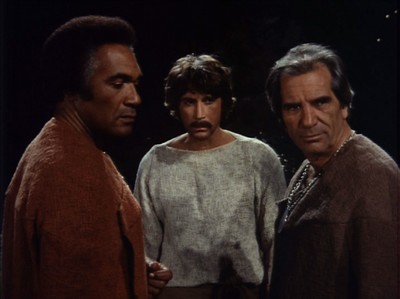
You must promise not to kill again
The program has other problems too. As his co-producer on his first television program since Star Trek, Roddenberry hired Paul Rapp, whose previous work consists mostly of Roger Corman cheapies. That shows in the look of the production, which is wildly uneven and often downright unattractive. Most of the money seems to have gone into the sub shuttle vehicle station and miniature effects (Genesis II’s version of Star Trek’s transporter), which are quite convincing and interesting. There’s a nice matte painting of Tyrania and the Tyranian council sets are impressive, but the mix of location work and small, low budget set pieces frequently gives the show a chintzy look (the Pax council chamber is particularly cramped and disappointing), especially in its frequent underground scenes both in Pax and Tyrania.
Looking back on the program without the benefit of nostalgia you’ll find a playground of unintentional laughs. The arch performances of the Tyranian elders in their wigs and Flesh Gordon peek-a-boo outfits are the stuff of Saturday Night Live skits—sometimes Genesis II comes off as a parody of dated, socially aware sci fi drama. It doesn’t help that Leon Haskins from Hogan’s Heroes and the preacher from Mel Brooks’ Blazing Saddles make appearances. Perhaps worst of all is a collection of horrendous Shirley Temple wigs for the Tyranian “helpers” that make every one of these characters we’re supposed to pity look ridiculous. Nevertheless Genesis II got a Hugo award nomination for best dramatic presentation and produced some initial excitement, but did not lead to a series commitment from CBS—they instead went for Planet of the Apes, which only lasted one season. Ironically Genesis II (and the later Planet Earth) owes more than a little to
Planet of the Apes, with its idea of a 20th century man flung forward in time to an “upside down” post-apocalyptic civilization.
Genesis II, like many TV pilots and TV movies from the seventies, never got an official home video or DVD release and apart from some syndicated TV airings has been little seen since its 1973 debut. Until now fans have had to contend with bootleg videos and DVDs that are of extremely poor quality, most looking like multi-generation copies of videotapes of broadcasts of the movie. While the Warner Archive DVD is minimal in terms of features and packaging, the picture quality, detail and color balance is excellent, with the pilot looking every bit as good as it did during its original broadcast. Since purchasers buy these directly online I suppose the box art doesn’t matter all that much but the Genesis II cover art is confounding— it seems to feature two unidentified female background players and makes the pilot look like some seventies mother/daughter after school special.
Planet Earth
With the large, standing sub shuttle set from Genesis II still intact, Roddenberry attempted to pitch the series concept to ABC and put together a second pilot. In many ways Planet Earth is a huge improvement on Genesis II, even though the basic plotline of the first movie is more interesting on its face. The second pilot keys off a throwaway line from the first in which Hartley’s Lyra-a tells Hunt he’s lucky he wasn’t caught in the “women’s country,” where men are treated as beasts of burden. In effect Planet Earth is just another episode in a very short-lived series, and it even demonstrates some of the limitations of the format, since in some ways it’s a retread of the first pilot’s idea of Dylan and his team infiltrating an oppressive society in order to foment a revolution.
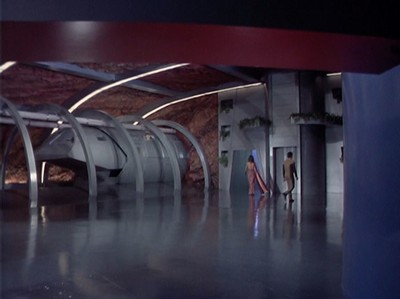
Sub shuttle station is back in Planet Earth
As with Star Trek’s “Where No Man Has Gone Before,” Roddenberry recast his lead, brought in a co-writer (Juanita Bartlett, who quickly went on to the hugely popular The Rockford Files), and made sure to avoid the dour and heavy, intellectual tone of Genesis II to make Planet Earth action-packed, light and fun. In doing so he probably got as close to the original feel of the first Star Trek series as he ever would in future efforts. Despite the fact that Planet Earth is in many ways a different show on another network, Roddenberry took full advantage of the groundwork laid in Genesis II. The second pilot shows Dylan Hunt (now played by John Saxon) as a Pax team leader, with a brief flashback showing Hunt and his team (Ted Cassidy, the only returning cast member from Genesis II as Isiah, Janet Margolin as Harper-Smythe, and Christopher Cary as Baylock, a scientist and “esper” who can heal with his mind). Rai Tasco plays “Pater” Kimbridge, basically the same character played by Percy Rodriguez in Genesis II. In a sequence very similar to the opening of the Roddenberry-written Trek episode “A Private Little War,” the flashback shows Hunt and his team escaping from the steampunk, militaristic “Kreegs” only to see Kimbridge shot before they can board a sub shuttle. After the leader is brought back to Pax, the search is on for a missing physician who can do the heart surgery that can save Kimbridge’s life.

Margolin’s Harper with captive Hunt, now played by John Saxon
Hearing that the missing physician, Jonathan Conner (!), had disappeared in a part of the country ruled by an amazon society called the Sisters of Ruth, Hunt and his team split up, with Hunt and Harper-Smythe infiltrating the matriarchy by telling the female leaders that Hunt is Harper-Smythe’s “property” and that she wants to join the matriarchy. One of the amazons’ leaders, Marg (Diana Muldaur), quickly challenges Harper-Smythe for the ownership of Hunt and takes him for herself, leaving Harper-Smythe to navigate the society alone. When Marg puts Hunt up for auction he finds Isiah and Baylock up for bid as well—cowering with a mysterious fear that all the male slaves—or “dinks,” of the society share. Hunt eventually seduces Marg while Harper-Smythe locates Conner (Jim Antonio), who has discovered the matriarchy’s secret of drugging the dinks’ food to keep them docile and compliant. Conner gets an antidote into the food just in time for the dinks to help fend off an attack by the Kreeg, leading the women to rethink their approach to the dinks and vote to withdraw the drug and deal with the dinks on an equal basis.
Planet Earth manages to outdo Genesis II on almost every level. Roddenberry hired producer Robert Justman and director Marc Daniels, both Star Trek veterans, and the result is a show that is bright, energetic and impressive-looking. The already well-done Pax sub shuttle station set is improved by art director Robert Kinoshita (who had worked on both Forbidden Planet and Lost in Space), while Bill Theiss’ mustard-colored jumpsuit uniforms give the Pax team a clean futuristic look. Even the props are uprated, with the Pax communicators and dart guns refinished with brighter details that give them the eye catching look of the Star Trek phasers and communicators.
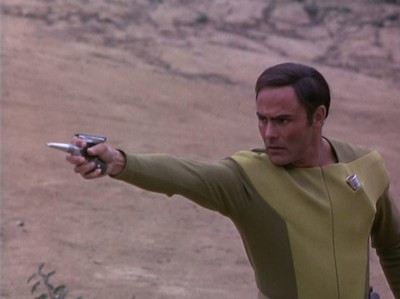
New Dart Gun, one of the jazzed up props in Planet Earth
The opening scenes quickly and efficiently establish the format as focusing on action and character. The Kreeg, with their proto-Klingon forehead spines and steam-powered war wagons, are interesting villains, driven by the mindless need for conflict, and the establishing scenes for the Pax team effortlessly sketch out strong character traits. As Hunt, Saxon is immediately more warm and Kirk-like than the dour Alex Cord—interesting since Saxon was much better known for playing crazed villains than heroes. His teasing relationship with Janet Margolin’s Harper-Smythe doesn’t carry the overtones of sexual harassment that Cord’s scenes with Lynne Marta did in the first pilot. Ted Cassidy has a nice moment where he’s tempted to use one of the Kreeg rifles to return fire on them during the Pax team’s escape, but instead he furiously smashes the offending weapon against a wall. Baylock is probably the least textured character of the team but he makes an effective impression as an intellectual operative with unusual insight. Whether Percy Rodriguez was available or not, his presence as Kimbridge is missed—but since the character does little more here than get shot, disappear through most of the story and reappear for a warm wrap-up, the role didn’t call for a higher profile actor.
“Special guest star” Diana Muldaur is also a Star Trek vet, with two appearances in classic Trek (and of course her one year regular stint as Dr. Pulaski in TNG). She’s effectively arrogant and patrician as Marg, selling the conflict between her and Harper-Smythe as well as some later amusing scenes between her and Saxon. The overall quality of performance in Planet Earth is much better than what’s obtained in Genesis II, and Marc Daniels deserves credit for that. Whatever you think of the style of acting on the original series, the show was rigorously rehearsed (something that William Shatner reportedly demanded), giving it an edge on much of the dramatic television of the period. You can see some of that theatrical approach in Planet Earth, particularly in the scenes between Muldaur and Saxon, which have the give and take of live theater. This in particular helps the humorous interplay that makes Planet Earth more “fun” than Genesis II. The pilot is also well-paced and edited, with several rhyming cuts and a nice transition between one of the amazons explaining how posturing, arrogant males destroyed the world to a scene of the bellicose Kreeg warriors who function as a satire of the military mindset.
I’ve always been a sucker for Janet Margolin’s Harper-Smythe—in fact I’ll go down on record as saying she’s my favorite Roddenberry-created female character. Her template, interestingly, is not Yeoman Rand or Uhura, but one of Roddenberry’s earlier inspirations: the tomboyish Yeoman Colt from “The Cage.” Like Colt, Harper-Smythe is efficient and comfortable in “away team” situations, and seems to have a sense of humor as well as a keen sense of her own failings. Both characters harbor not-so-secret feelings for their commanders, and both find themselves outted and embarrassed by those feelings over the course of their stories. Janet Margolin isn’t a great actress but she’s attractive in an appealing androgynous way that was unusual for the period, when big-haired models or glamorous hippy chicks were more common. Harper-Smythe isn’t exactly Ellen Ripley but she’s shown as adept at combat when required, whipping both Marg and another Sister of Ruth when the situation demands it. It’s unfortunate that she winds up a helpless hostage to the Kreeg at the episode’s climax, getting knocked around and sidelined while Marg gets in at least a punch or two. I love Harper-Smythe’s moment with the mysterious John Conner when the Pax physician asks who Hunt is (after finding Harper-Smythe in a compromising position with the drugged Saxon): “My team leader,” she says ruefully, eyes rolling a little at her own poor judgment. There’s another moment when Harper-Smythe strong-arms one of the amazon leaders who’s invited her into her home. “I came her for directions and I’m damn well going to get them!” she growls as she pins the woman’s arm behind her back. This mirrors a scene in Genesis II in which the shock wave from a nuclear explosion Hunt has triggered strikes on a Pax lookout just as a mother has brought her young children out to see the stars. There and in the Planet Earth scene, the heroes witness the effect of their own violence on children, forcing them to rethink the use of force—a very effective and intelligent pacifistic touch from Roddenberry. For Harper-Smythe, the balance of what passed for a “kick-ass” female action hero and a vulnerable young woman working out her position in her society and vis-à-vis Hunt’s strange leader would have made for an attractive weekly character I think.
Planet Earth has never won plaudits for what seems its condescending depiction of a matriarchal society, but at least credit Roddenberry (always a target for classic Trek’s miniskirted sexism) for hiring Juanita Bartlett to give the teleplay a female perspective. I would credit Bartlett for the lion’s share of the script’s clever and playful sexual politics and dialogue—as her work on The Rockford Files would quickly prove, she was one of the smartest writers working in television, and a Planet Earth series with her as story editor could have been very promising. While Genesis II featured a number of unintentionally funny lines, Planet Earth’s humor is nothing if not intentional, right down to the diminutive, humiliating term “dink” for the matriarchy’s male slaves. It grates on the ear but has a nice payoff in a scene between Harper-Smythe and Conner as the two discuss Hunt’s chances of winning over Marg, which Conner says will depend on Hunt’s understanding of female psychology. “I don’t think he knows the first thing about it,” Harper-Smythe says. “Well,” Conner replies, “You never know about us dinks.”
The pilot climaxes with a tense showdown between the Kreeg, the Sisters of Ruth, the dinks and Hunt’s Pax team, and with limited resources Marc Daniels manages to make it relatively exciting. You have to love Saxon delivering a full-on Captain Kirk drop-kick to a Kreeg and the huge Isiah jumping a fence on horseback to wade into the battle.
Roddenberry hired Harry Sukman to score both pilots, an odd choice considering the availability of all of the original Trek’s superb and experienced composers, from Sandy Courage, Fred Steiner and Gerald Fried to George Duning and Sol Kaplan. Sukman did have a few sci fi credits—two fifties films, Riders to the Stars and the ridiculous robot thriller Gog, and the waterlogged 1966 Ivan Tors adventure Around the World Beneath the Sea. Sukman wrote a nice, exciting theme for Genesis II with a particularly sweeping bridge that doubles as an effectively exotic love theme for Hunt and Lyra-a. His Planet Earth theme is bombastic and action-oriented but far less memorable—although he is good at giving the plight of the oppressed in both shows a grim, semi-biblical epic feeling. For some reason Sukman gets into a weird Batman area in scoring the final action scene in Planet Earth with some brass stylings worthy of Nelson Riddle—you almost expect a few BAM! and POW! cartoon balloons to pop onscreen. In another musical note (pun intended), the harpsichordist in the house Harper-Smythe first goes to for shelter is Craig Hundley (nee Huxley), seen in the Trek episode “And the Children Shall Lead” and the inventor of the Blaster Beam instrument used in the V’ger cues in Jerry Goldsmith’s
Star Trek – The Motion Picture score.
For all its strengths, Planet Earth failed to earn a series commitment from ABC (they perhaps wisely chose The Six Million Dollar Man, which became a huge hit for them). Oddly enough, John Saxon starred in one final attempt to position the concept as a series, the 1975 pilot Strange New World, which was directed by Robert Butler—the man who’d directed Star Trek’s “The Cage” pilot in 1964. This time there was no involvement from Roddenberry and once again, the pilot failed to sell, burying the concept for good—but it was also produced by Warner Bros, so at least we may see an archival DVD of it some day. Genesis II and Planet Earth shared a lot of the vices of seventies science fiction—endless location shooting in the scrub brush of Southern California, winking sexuality and a lot of indifferently-staged stunt man action. But the concept also showed some promise and has a particular appeal as a kind of earthbound Star Trek. Several concepts and plotlines from the show later appeared in other Roddenberry productions from
Star Trek – The Motion Picture to Andromeda, which revived the character name Dylan Hunt. But none quite captured the appeal of Planet Earth, which was made just close enough to the original Star Trek episodes to capture a little bit of their particular energy, style and humor. Roddenberry was quoted at the time as pointing out that despite its seemingly depressing post-apocalypse setting, the Genesis II/Planet Earth concept was perhaps even more inherently optimistic than Star Trek. “The concept of the show says look, we can survive even this, the destruction of our civilization,” Roddenberry said, and the pilot’s (stock) footage of a natural wilderness re-emerging from the crush of urban sprawl and blight still gets that message across. Particularly now on a world running out of resources and threatening to heat up to the point of uninhabitability, there’s an appeal to the idea of starting over.
Available now
Both Genesis II and Planet Earth are available on DVD now for $19.95 each via Warner Bros. Archive. DVDs have no special features.
You can also get both titles in a value-pack for $29.99 at the WB Shop.
CLIPS:
